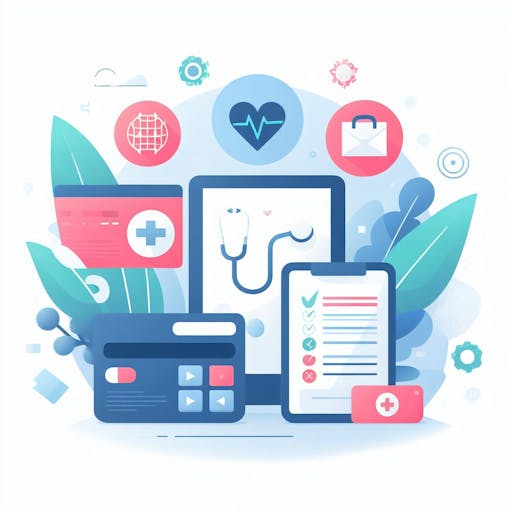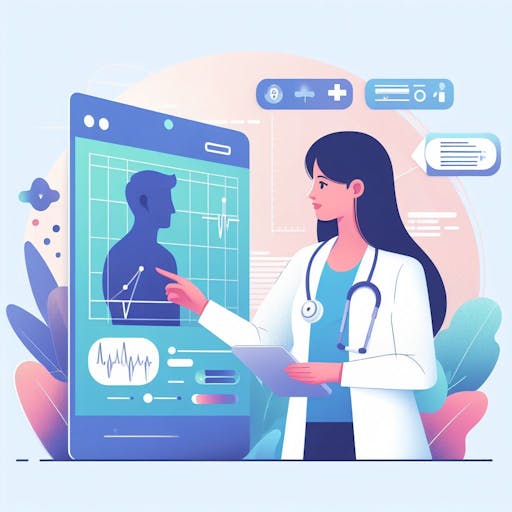Optimizing your healthcare tech stack: essential tools

Tools for digital healthcare companies
Whether you’re a healthcare professional who’s witnessed pain points firsthand or have a personal experience that inspired you to launch a digital health company, you know the importance of providing innovative solutions to healthcare challenges. You might have the technological chops to start building now or you’re putting together a strong team who can actualize your vision.
The digital health space has plenty of room for emerging businesses that offer exceptional products and provide excellent patient care, especially with the shift towards value-based care. Online healthcare is a powerful solution for a wide range of patients, including those who are:
- Immunocompromised
- Frustrated with long wait times at brick-and-mortar facilities
- Looking for care in the privacy of their own homes
- Pursuing holistic or innovative medicines
- Geographically remote from their providers.
In this article, we’ll provide an in-depth exploration of the key tools and steps to start and optimize your digital healthcare company. You’ll gain insights into essential tech stacks, including a patient-facing form builder, aimed at streamlining your operations and providing top-notch care.
Build vs buy in healthcare
Defining which areas of your offering are core to the business and which you should outsource is one of the biggest challenges you’ll face in the early stages of your business. And it will happen many times during the lifecycle of your startup. It might be tempting to build each tool in-house, especially the solutions whose complexities may not initially be apparent. You’d need to gain expertise in what you are developing, which means you’d be spending your valuable time on that instead of your real mission.
Rather than reinventing the wheel in areas where well-optimized market solutions exist, your engineering team should focus on the areas they can add the most value–solving the challenges unique to your business. By strategically utilizing existing solutions for non-core functionalities, you can optimize resource allocation, accelerate your time-to-market, and ultimately position your digital health company for greater success. Form Health, for example, saved thousands of engineering hours by choosing great-fit tools for forms, analytics, and other important tools.
Essential tools for your healthcare tech stack
Selecting the right tools is a pivotal step toward ensuring your venture's success. In this section, we'll comprehensively cover each of these categories:
- Form builders
- Electronic health records (EHRs)
- Scheduling Tools
- Patient communication tools
- Billing & insurance verification tools
- Telehealth (all-in-one tools)

HIPAA-compliant form builder
A HIPAA-compliant form builder is the cornerstone of secure patient data collection. It allows you to create, distribute, and manage electronic forms for patient qualification, patient intake, consent and medical history. This tool ensures strict adherence to privacy regulations, safeguarding sensitive health information. There are many excellent form builders that can help you can create forms not only to streamline data collection but to create personalized patient journeys that help build strong relationships between you and your clients.
Formsort - Create, modify and deploy highly customizable forms that align with your brand identity and specific needs. With features like conditional logic, seamless integration, and advanced analytics, Formsort streamlines data collection processes while providing valuable insights, making it an ideal choice for digital health businesses seeking efficient and versatile form-building solutions.
Jotform - Great for simple forms, Jotform lets users leverage form templates for quick starts, integrate with a variety of third-party applications, and enhance forms with widgets like electronic signatures and file uploads. Collaboration tools, mobile responsiveness, and secure payment processing are also part of Jotform's feature set.
Typeform - With this form builder you can create forms, surveys, and quizzes that don’t need to be super customized. It has an intuitive interface, some conditional logic and integration options, simplifying the process of designing interactive and responsive forms that encourage user engagement.
Electronic health records (EHR) system
An EHR system serves as the digital backbone of modern healthcare, providing a centralized repository for comprehensive patient health records. It streamlines documentation, facilitates information sharing between healthcare providers, and enhances patient care coordination. EHRs also help improve patient care by providing quick access to a patient's medical history, lab results, medications, and treatment plans. Some EHR systems you can consider are:
Healthie - Healthie offers a suite of tools for nutritionists, dietitians, and wellness professionals to manage their practices efficiently. It features electronic health records, appointment scheduling, telehealth capabilities, secure messaging, and a mobile app for clients to track their progress. Healthie supports personalized care and allows professionals to deliver services effectively, making it an valuable resource for those in the nutrition and wellness fields. Among their 2,000 customers you can find Oscar Health, Parsley Healse, and Season Health.
Medplum - Focused on providing secure and patient-centric solutions for managing health information, Medplum’s primary offering is a personal health record (PHR) platform that allows individuals to take control of their health data. Users can securely store and manage their medical records, share information with healthcare providers, and access their health information from anywhere. Medplum prioritizes data security and patient privacy, making it a trusted choice for individuals seeking greater control over their health records. Thirty Madison, Summer Health, and HumanFirst are all using Medplum.

Scheduling tools
Playing a pivotal role in healthcare by streamlining appointment management, improving resource allocation, and enhancing patient engagement, scheduling tools enable patients to easily book appointments online, receive automated reminders, and contribute to efficient practice operations by reducing no-show rates. Acuity Scheduling, Cal.com and Healthie are creating innovative solutions in scheduling. You can read more about them here.
Patient communication
Patient communication tools are a vital component of digital health solutions, enabling secure messaging, appointment reminders, and educational content sharing. They foster patient engagement, encourage adherence to treatment plans, and enhance the overall patient experience. Some tools that are optimizing patient communication are:
Klara - A comprehensive patient communication platform, Klara enables secure messaging between patients and providers, simplifying appointment scheduling, prescription refills, and follow-up care. Klara's user-friendly interface and integrations with electronic health record (EHR) systems enhance care coordination and patient engagement.
Spruce Health - Offering secure messaging, appointment reminders, and telemedicine capabilities, Spruce Health provides a comprehensive patient communication and engagement platform for healthcare practices. It also focuses on improving patient adherence to treatment plans and simplifying administrative tasks for healthcare providers.
OhMD - OhMD specializes in secure and compliant patient messaging solutions. It allows healthcare teams to communicate with patients via text messages, reducing reliance on phone calls and improving response times. OhMD's platform enhances patient engagement and supports HIPAA-compliant communication.
Twilio Healthcare Solutions - Offering a suite of communication solutions tailored for the healthcare industry, Twilio’s platform provides secure messaging, voice, and video capabilities that enable healthcare providers to engage with patients effectively. Twilio's communication tools enhance patient interactions and contribute to care continuity.
Billing & insurance verification tools
Payment processing solutions
Payment processing solutions streamline billing and payment collection. They support various payment methods, generate invoices, and integrate with insurance systems. These tools simplify financial transactions, reducing administrative overhead. While these solutions don't necessarily have to be HIPAA-compliant, there are advantages to using medical insurance billing checkouts.
HIPAA-compliant payment processing ensures the protection of sensitive patient data, fostering trust and compliance with healthcare regulations. By incorporating medical insurance billing checkouts into their systems, you can simplify your billing process, reducing claim denials and improving revenue capture. This not only streamlines financial operations but also enhances the patient experience by reducing administrative hassles and ensuring accurate billing, ultimately leading to more transparent and efficient healthcare transactions.
The 5 phases of a medical bill
When we talk about simplifying the billing process, we’re referring to a complex 5-step procedure that works to ensure that healthcare services are accurately billed, payments are received, and any outstanding balances are appropriately addressed, contributing to the financial sustainability of healthcare organizations.
The five phases of a medical bill encompass the entire billing process in healthcare:
- Pre-appointment: This phase involves verifying a patient's insurance coverage and eligibility before their appointment. It ensures that the healthcare provider can bill the correct insurance provider for the services rendered.
- Point of care: During the patient's visit, healthcare providers may collect copayments or initial payments for services rendered, depending on the insurance plan.
- Claim submission: After the appointment, the healthcare provider submits a claim to the patient's insurance company, detailing the services provided and their associated costs. This phase initiates the reimbursement process.
- Insurance payment or denial: The insurance company reviews the claim and either approves it for payment or denies it based on coverage rules and medical necessity. If approved, the insurer issues payment to the healthcare provider.
- Patient payment: In cases where the insurance doesn't cover the full cost of services or if the patient has a deductible or coinsurance, the patient is responsible for the remaining balance. The healthcare provider sends a bill to the patient for this amount, which the patient is expected to pay.

You can use a standard payment platform like Stripe or consider using one of these medical insurance billing checkout tools:
Adonis offers a comprehensive medical billing solution tailored for healthcare providers. It streamlines insurance claims processing, ensuring accurate billing and prompt reimbursement. Adonis also facilitates patient payments, making it a valuable tool for revenue cycle management in healthcare.
Apero Health specializes in revenue cycle management solutions for healthcare companies. Its medical insurance billing checkout tools help providers verify patient insurance information, calculate copays, and ensure accurate claims submission. Apero's platform is designed to optimize financial operations in healthcare.
Candid is a medical insurance billing checkout tool that simplifies the billing process. It focuses on verifying insurance eligibility, automating claims submission, and streamlining patient payments. Candid helps healthcare providers enhance billing accuracy and reduce administrative overhead.
Enter Health offers a suite of healthcare revenue cycle management solutions, including medical insurance billing checkout tools. Its platform supports insurance verification, claims processing, and patient payments. Enter Health's tools contribute to efficient financial operations and improved revenue capture for healthcare providers.
These medical insurance billing checkout tools are designed to cater specifically to the unique needs of healthcare billing and revenue cycle management, ensuring accurate reimbursement and financial sustainability for healthcare organizations.
Insurance eligibility and benefits verification
Insurance verification software automates the process of confirming patients' insurance coverage and eligibility. These solutions enhance billing accuracy, reduce claim denials, and improve the overall financial health of healthcare organizations.
- Opkit offers a comprehensive platform for insurance eligibility and benefits verification. It streamlines the process of checking patients' insurance coverage, including copay and deductible information. Opkit's user-friendly interface and integration capabilities with various electronic health record (EHR) systems make it a valuable tool for healthcare providers seeking to optimize revenue cycle management.
- Nirvana provides an insurance eligibility and benefits verification platform designed to enhance billing efficiency. It offers real-time verification, reducing the risk of claim denials and ensuring that healthcare providers have accurate insurance information. With Nirvana's services, healthcare organizations can streamline their revenue cycle processes and improve cash flow.
- Apero Health specializes in revenue cycle management solutions, including insurance eligibility and benefits verification. Its platform helps healthcare providers verify patient insurance coverage, copay amounts, and deductibles promptly. Apero Health's automation capabilities reduce manual tasks, improving administrative efficiency and revenue capture for healthcare organizations.
These companies offer digital health tools that simplify insurance eligibility and benefits verification, ultimately contributing to more accurate billing processes and financial stability for healthcare providers.
Telehealth - clinician staffing, appointment scheduling and video calling
If you’re planning to conduct any of your services virtually, telemedicine platforms can be an indispensable part of providing them securely. They’ll enable remote consultations, video visits, and secure communication between your patients and healthcare providers. Some even offer provider staffing, connecting you to a vast network of medical professionals to select from for your company.
Companies like Wheel, OpenLoop Health, SteadyMD, Elation Health, and CarePatron, among others, are some of the comprehensive telehealth platforms you can tap into for your startup.
- Wheel is a telemedicine platform that includes clinician staffing, scheduling, and video calling capabilities. It focuses on connecting healthcare providers with patients through secure and efficient virtual consultations. Wheel's network of clinicians enables a wide range of healthcare services to be delivered digitally, enhancing patient access to care.
- OpenLoop Health provides a clinician network and telemedicine platform designed to improve healthcare accessibility. Their platform supports virtual consultations, connecting clinicians with patients across geographical distances. OpenLoop Health's solutions contribute to expanding the reach of healthcare services, particularly in underserved areas.
- Carepatron is a complete practice management software solution that offers a range of features including telehealth, electronic health records, patient documentation and notation software and more, allowing healthcare practitioners to manage all their work in one place.
- SteadyMD offers a unique approach to telehealth by providing personalized primary care services through a dedicated virtual clinician. Patients receive ongoing, one-on-one care from their chosen clinician, fostering a strong patient-provider relationship. SteadyMD's telehealth model offers comprehensive care and continuous support to patients.
- Elation Health focuses on enhancing physician-patient interactions. It supports secure video visits, enabling healthcare providers to connect with patients remotely. Elation Health's platform promotes efficient care delivery while maintaining the quality of the patient-provider relationship.
Optimizing your tech stack for success
Integration and interoperability
The importance of seamless tool integration can’t be overstated. It's the glue that holds your tech stack together, enabling the smooth flow of data and information across essential systems and applications. Healthcare organizations rely on a multitude of tools and systems, such as electronic health records (EHRs), telemedicine platforms, billing systems, and more. These tools must work in harmony to provide comprehensive patient care and efficient operations.
Seamless integration lets you access a holistic view of patient information, leading to better-informed clinical decisions and improved patient care. For example, when a patient schedules a telehealth appointment through your digital platform, integration ensures that this information seamlessly flows into the EHR system. This means their provider can access the patient's medical history, current medications, and previous diagnoses during the virtual consultation, enhancing the quality of care.
Interoperability goes beyond internal systems. It also extends to external partnerships and collaborations. Interoperable systems can communicate with those of external partners, such as laboratories, pharmacies, and insurance providers, streamlining processes like test ordering, prescription filling, and claims processing. The result is a more efficient and patient-centric healthcare ecosystem.
Strategies for integration and interoperability
Developing a comprehensive integration and interoperability strategy that aligns with your organizational goals and priorities will save you a lot of hassle down the line. It means pre-assessing any tools you’re considering using for compatibility with your existing tech stack and having a detailed plan to build the required integrations. You’ll need to
- Adhere to industry standards and protocols, such as HL7 and FHIR (Fast Healthcare Interoperability Resources), to facilitate data exchange between systems.
- Leverage APIs to enable smooth communication between different systems and applications since APIs allow data to be shared securely and efficiently.
- Collaborate with vendors and developers to ensure that your systems offer well-documented and accessible APIs for integration purposes.
- Prioritize data security and compliance with healthcare regulations like HIPAA.
- Implement encryption, access controls, and audit trails to protect patient data during integration.
- Regularly audit and assess your systems for compliance with data privacy laws.
- Implement monitoring tools and processes to track the performance of integrated systems. Identify and resolve issues promptly to minimize disruptions.

Scalability and future-proofing
Scalability means your technology infrastructure can grow and adapt to meet the changing needs and demands of your healthcare organization. A scalable tech infrastructure ensures you can accommodate increased user volumes, additional services, and emerging technologies without significant disruptions or overhauls.
By investing in a scalable tech stack, you future-proof your digital health company against the challenges of obsolescence and rapid industry changes. As your patient base grows, your technology should scale to handle increased data, traffic, and processing requirements. Scalability also allows you to integrate new tools and technologies as they emerge, staying at the forefront of healthcare innovation.
Scalability supports your financial goals by ensuring cost-effectiveness. Instead of investing in entirely new systems as your organization expands, you can leverage existing infrastructure, reducing the total cost of ownership and optimizing your return on investment.
Power your digital health forms with Formsort
With the support of technology, digital health is bringing back the experience of having a physician make house calls and enhancing that call with access to the most advanced diagnostic tools, treatments, and entire medical support teams available. Your patients get personal medical care in the privacy of their homes without having to travel and sit in a waiting room full of other sick people. They receive world class care from anywhere in the world. Utilize tools like Formsort to build a robust tech stack so you can focus on serving your patients.